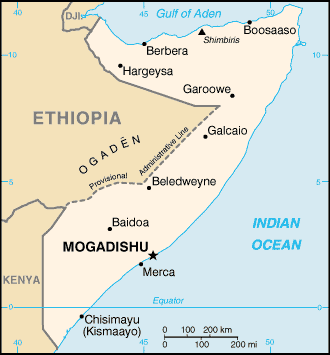Persecuted church list...
Map:

Overview:
The regime of Mohamed SIAD Barre was ousted in January 1991; turmoil, factional fighting, and anarchy have followed in the years since. In May of 1991, northern clans declared an independent Republic of Somaliland that now includes the administrative regions of Awdal, Woqooyi Galbeed, Togdheer, Sanaag, and Sool. Although not recognized by any government, this entity has maintained a stable existence, aided by the overwhelming dominance of a ruling clan and economic infrastructure left behind by British, Russian, and American military assistance programs. The regions of Bari and Nugaal and northern Mudug comprise a neighboring self-declared autonomous state of Puntland, which has been self-governing since 1998, but does not aim at independence; it has also made strides towards reconstructing a legitimate, representative government, but has suffered some civil strife. Puntland disputes its border with Somaliland as it also claims portions of eastern Sool and Sanaag. Beginning in 1993, a two-year UN humanitarian effort (primarily in the south) was able to alleviate famine conditions, but when the UN withdrew in 1995, having suffered significant casualties, order still had not been restored. The mandate of the Transitional National Government (TNG), created in August 2000 in Arta, Djibouti, expired in August 2003. New Somali President Abdullahi YUSUF Ahmed has formed a new Transitional Federal Government (TFG) consisting of a 275-member parliament. It was established in October 2004 to replace the TNG but has not yet moved to Mogadishu. Discussions regarding the establishment of a new government in Mogadishu are ongoing in Kenya. Numerous warlords and factions are still fighting for control of the capital city as well as for other southern regions. Suspicion of Somali links with global terrorism further complicates the picture.
The People:
Population: 8,591,629
note: this estimate was derived from an official census taken in 1975 by the Somali Government; population counting in Somalia is complicated by the large number of nomads and by refugee movements in response to famine and clan warfare (July 2005 est.)
Age structure:
0-14 years: 44.5% (male 1,918,209/female 1,905,974)
15-64 years: 52.9% (male 2,278,406/female 2,263,602)
65 years and over: 2.6% (male 96,256/female 129,182) (2005 est.)
Religions:
Sunni Muslim
Government Type:
no permanent national government; transitional, parliamentary federal government
Leader(s) to pray for:
chief of state: Abdullahi YUSUF Ahmed (since 14 October 2004); note - a new Transitional Federal Government consisting of a 275-member parliament was established in October 2004 but remains resident in Nairobi, Kenya, and has not extablished effective governance inside Somalia
head of government: Prime Minister Ali Muhammad GHEDI (since 24 December 2004)
Source: The World Factbook
View All Countries